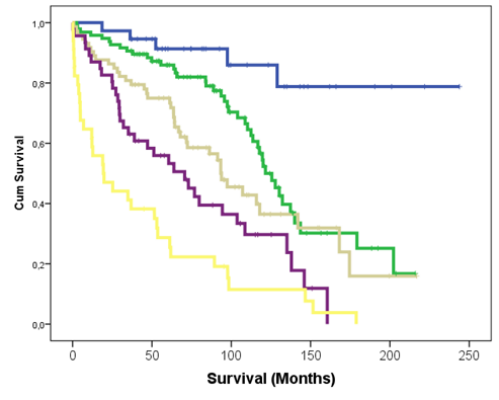A REVISED STAGING SYSTEM FOR WALDENSTRÖM'S MACROGLOBULINEMIA
(Abstract release date: 05/18/17)
EHA Library. Kastritis E. 06/24/17; 181702; S415

Dr. Efstathios Kastritis
Contributions
Contributions
Abstract
Abstract: S415
Type: Oral Presentation
Presentation during EHA22: On Saturday, June 24, 2017 from 12:15 - 12:30
Location: Hall B
Background
Waldenström’s macroglobulinemia (WM) is a rare low-grade B-cell lymphoma characterized by the lymphoplasmacytic bone marrow infiltration and the presence of monoclonal IgM immunoglobulin in the serum. WM is an indolent lymphoma that has heterogeneous clinical manifestations and patients with this disease may have a prolonged disease course; however, there are groups of patients with poor outcomes after a relatively short disease course. In order to develop a robust staging system a collaborative effort resulted in the formulation of the International Prognostic Scoring System for WM (IPSSWM) which was developed in 2009 based on data of patients that were treated primarily without rituximab and mainly with alkylators and nucleoside analogues. IPSSWM is based on five covariates (age, hemoglobin, platelet counts, IgM levels and b2 microglobulin) and stratifies WM patients into 3 broad risk groups. IPSSWM does not take into account non-WM related mortality, which is common and quite different among patients over the age of 75 year and does not include LDH, which is a well identified prognostic factor both in lymphomas and multiple myeloma.
Aims
The aim of the current study was to revise the current IPSSWM by using a large dataset of symptomatic WM patients treated with different types of primary therapy that included rituximab and other new agents
Methods
The analysis included 492 patients from the prospectively maintained database of the Greek Myeloma Study Group with a median follow up of 10 years. All patients fulfilled criteria for diagnosis and for treatment initiation according to Consensus Recommendations
Results
In univariate analysis factors such as age, beta-2 microglobulin, serum albumin and LDH were all associated with poor outcome. The IPSSWM includes age and b2 microglobulin but not serum albumin, or LDH, while the presence of very high IgM (>7 gr/dl) was quite rare and of limited prognostic value. The presence of anemia <11.5 gr/dl was common across all subgroups while low platelet counts <100 x 109/L was found in relatively few patients and had no prognostic significance. Based on ROC analysis for early death (within 3 years), serum albumin <3.5 gr/dL and b2microglobulin >4 mg/L were the two most important prognostic factors of early WM-related death. Age >65 years was associated with increased risk of death, however, age >75 years conferred additional risk (double hazard of death compared to those 65-75 years and fourfold compared to patients <65 years). Thus, we formulated a score in which high b2 microglobulin, elevated LDH and low serum albumin are scored with 1 point each, age 66-75 years is scored with 1 point but age >75 years is scored with 2. As a result, patients with scores 0, 1, 2, 3 or 4-5 had 3-year WM-related death rate of 3%, 7%, 14%, 19% and 48% (chi-square: 80.7, p<0.001). Regarding overall survival, 10-year survival rate was 85%, 59%, 39%, 28% and 12% (p<0.001) (Figure 1). Because age is a major determinant of disposition we also evaluated this staging system in patients >65 years and retained it prognostic significance. Compared to IPSSWM, this new staging system outperformed ISSWM: c-statistics, a measure of performance of a prognostic tool, was 0.652 for IPSSWM (95%CI 0.627-0.677) vs 0.711 (95% CI 0.659-0.763) for the new staging system.

Conclusion
A revised staging system, based on b2 microglobulin, elevated LDH, low serum albumin and age identifies groups with very different outcomes among patients with symptomatic WM treated with contemporary regimens and may outperform IPSSWM.
Session topic: 19. Indolent Non-Hodgkin lymphoma - Clinical
Keyword(s): Waldenstrom's macroglobulinemia, Prognostic factor, Beta-2 microglobulin, Age
Abstract: S415
Type: Oral Presentation
Presentation during EHA22: On Saturday, June 24, 2017 from 12:15 - 12:30
Location: Hall B
Background
Waldenström’s macroglobulinemia (WM) is a rare low-grade B-cell lymphoma characterized by the lymphoplasmacytic bone marrow infiltration and the presence of monoclonal IgM immunoglobulin in the serum. WM is an indolent lymphoma that has heterogeneous clinical manifestations and patients with this disease may have a prolonged disease course; however, there are groups of patients with poor outcomes after a relatively short disease course. In order to develop a robust staging system a collaborative effort resulted in the formulation of the International Prognostic Scoring System for WM (IPSSWM) which was developed in 2009 based on data of patients that were treated primarily without rituximab and mainly with alkylators and nucleoside analogues. IPSSWM is based on five covariates (age, hemoglobin, platelet counts, IgM levels and b2 microglobulin) and stratifies WM patients into 3 broad risk groups. IPSSWM does not take into account non-WM related mortality, which is common and quite different among patients over the age of 75 year and does not include LDH, which is a well identified prognostic factor both in lymphomas and multiple myeloma.
Aims
The aim of the current study was to revise the current IPSSWM by using a large dataset of symptomatic WM patients treated with different types of primary therapy that included rituximab and other new agents
Methods
The analysis included 492 patients from the prospectively maintained database of the Greek Myeloma Study Group with a median follow up of 10 years. All patients fulfilled criteria for diagnosis and for treatment initiation according to Consensus Recommendations
Results
In univariate analysis factors such as age, beta-2 microglobulin, serum albumin and LDH were all associated with poor outcome. The IPSSWM includes age and b2 microglobulin but not serum albumin, or LDH, while the presence of very high IgM (>7 gr/dl) was quite rare and of limited prognostic value. The presence of anemia <11.5 gr/dl was common across all subgroups while low platelet counts <100 x 109/L was found in relatively few patients and had no prognostic significance. Based on ROC analysis for early death (within 3 years), serum albumin <3.5 gr/dL and b2microglobulin >4 mg/L were the two most important prognostic factors of early WM-related death. Age >65 years was associated with increased risk of death, however, age >75 years conferred additional risk (double hazard of death compared to those 65-75 years and fourfold compared to patients <65 years). Thus, we formulated a score in which high b2 microglobulin, elevated LDH and low serum albumin are scored with 1 point each, age 66-75 years is scored with 1 point but age >75 years is scored with 2. As a result, patients with scores 0, 1, 2, 3 or 4-5 had 3-year WM-related death rate of 3%, 7%, 14%, 19% and 48% (chi-square: 80.7, p<0.001). Regarding overall survival, 10-year survival rate was 85%, 59%, 39%, 28% and 12% (p<0.001) (Figure 1). Because age is a major determinant of disposition we also evaluated this staging system in patients >65 years and retained it prognostic significance. Compared to IPSSWM, this new staging system outperformed ISSWM: c-statistics, a measure of performance of a prognostic tool, was 0.652 for IPSSWM (95%CI 0.627-0.677) vs 0.711 (95% CI 0.659-0.763) for the new staging system.

Conclusion
A revised staging system, based on b2 microglobulin, elevated LDH, low serum albumin and age identifies groups with very different outcomes among patients with symptomatic WM treated with contemporary regimens and may outperform IPSSWM.
Session topic: 19. Indolent Non-Hodgkin lymphoma - Clinical
Keyword(s): Waldenstrom's macroglobulinemia, Prognostic factor, Beta-2 microglobulin, Age
{{ help_message }}
{{filter}}


